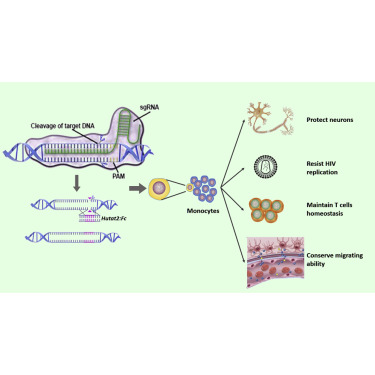Molecular Therapy - Nucleic Acids ( IF 6.5 ) Pub Date : 2018-02-07 , DOI: 10.1016/j.omtn.2018.01.012 Bowen Wang , Jiahui Zuo , Wenzhen Kang , Qianqi Wei , Jianhui Li , Chunfu Wang , Zhihui Liu , Yuanan Lu , Yan Zhuang , Bianli Dang , Qing Liu , Wen Kang , Yongtao Sun

|
The ability of monocytes to travel through the bloodstream, traverse tissue barriers, and aggregate at disease sites endows these cells with the attractive potential to carry therapeutic genes into the nervous system. However, gene editing in primary human monocytes has long been a challenge. Here, we applied the CRISPR/Cas9 system to deliver the large functional Hutat2:Fc DNA fragment into the genome of primary monocytes to neutralize HIV-1 transactivator of transcription (Tat), an essential neurotoxic factor that causes HIV-associated neurocognitive disorder (HAND) in the nervous system. Following homology-directed repair (HDR), ∼10% of the primary human monocytes exhibited knockin of the Hutat2:Fc gene in the AAVS1 locus, the “safe harbor” locus of the human genome, without selection. Importantly, the release of Hutat2:Fc by these modified monocytes protected neurons from Tat-induced neurotoxicity, reduced HIV replication, and restored T cell homeostasis. Moreover, compared with lentiviral transfection, CRISPR-mediated knockin had the advantage of maintaining the migrating function of monocytes. These results establish CRISPR/Cas9-mediated Hutat2:Fc knockin monocytes and provide a potential method to cross the blood-brain barrier for HAND therapy.
中文翻译:

使用CRISPR / Cas9生成Hutat2:Fc敲入人类原代单核细胞
单核细胞穿过血流,穿越组织屏障并在疾病部位聚集的能力赋予这些细胞极具吸引力的潜力,可将治疗性基因带入神经系统。然而,人类原代单核细胞中的基因编辑长期以来一直是一个挑战。在这里,我们应用了CRISPR / Cas9系统将大的功能性Hutat2:Fc DNA片段传递到原代单核细胞的基因组中,以中和HIV-1转录反式激活因子(Tat),后者是导致HIV相关神经认知障碍(HAND)的重要神经毒性因子。 )在神经系统中。进行同源性定向修复(HDR)后,约有10%的人类原代单核细胞在AAVS1中表现出Hutat2:Fc基因的敲入位点,人类基因组的“安全港”位点,无需选择。重要的是,这些修饰的单核细胞释放的Hutat2:Fc保护神经元免受Tat诱导的神经毒性,减少HIV复制并恢复T细胞稳态。此外,与慢病毒转染相比,CRISPR介导的敲入蛋白具有维持单核细胞迁移功能的优势。这些结果建立了CRISPR / Cas9介导的Hutat2:Fc敲入单核细胞,并提供了一种穿越血脑屏障进行HAND治疗的潜在方法。











































 京公网安备 11010802027423号
京公网安备 11010802027423号